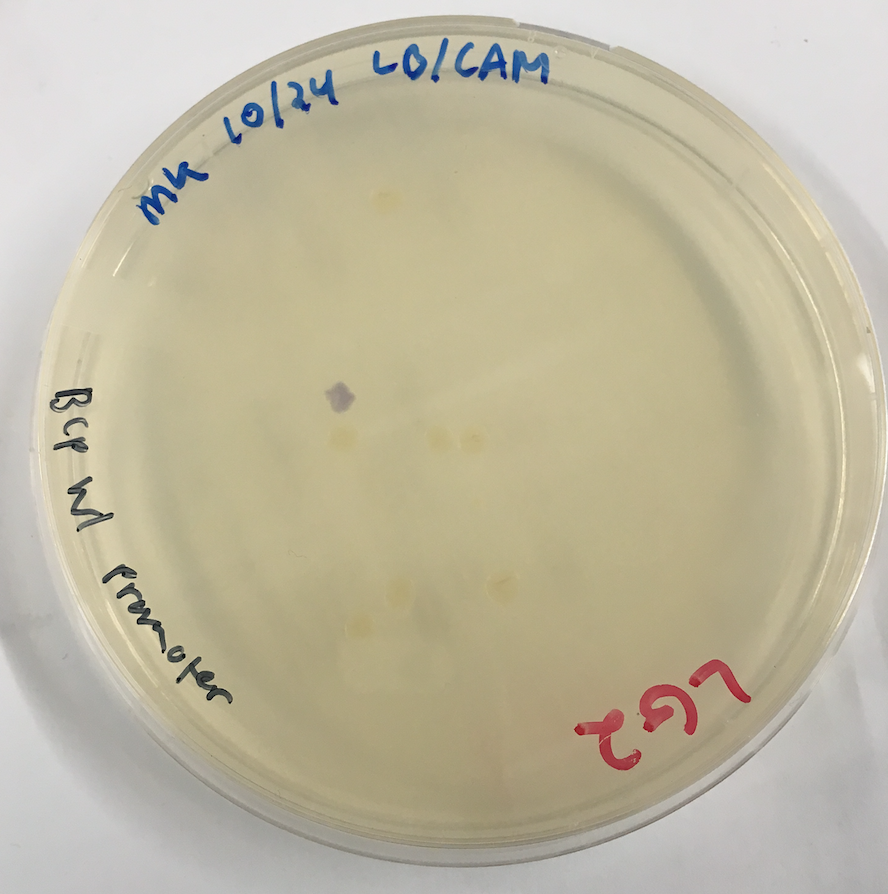| Line 18: | Line 18: | ||
| + | <div class="column half_size" | ||
</html> | </html> | ||
[[File:T--Austin UTexas--blueplate.png|thumb|center|400px|'''Figure 1.''' The image above shows the transformation plate of the electroporation of the codon-optimized blue chromoprotein. The blue colony shown was used to make overnight cultures to miniprep and sequence.]] | [[File:T--Austin UTexas--blueplate.png|thumb|center|400px|'''Figure 1.''' The image above shows the transformation plate of the electroporation of the codon-optimized blue chromoprotein. The blue colony shown was used to make overnight cultures to miniprep and sequence.]] | ||
| + | <html> | ||
| + | </div> | ||
| + | <div class="column half_size" | ||
| + | </html> | ||
[[File:T--Austin UTexas--blueculture.png|thumb|center|upright=0.4|'''Figure 2.'''The overnight culture of the phenotypically blue colony from the codon-optimized blue chromoprotein transformation.]] | [[File:T--Austin UTexas--blueculture.png|thumb|center|upright=0.4|'''Figure 2.'''The overnight culture of the phenotypically blue colony from the codon-optimized blue chromoprotein transformation.]] | ||
| + | </div> | ||
<html> | <html> | ||
<h4 style="font-family: verdana">Improvements</h4> | <h4 style="font-family: verdana">Improvements</h4> | ||
<p style="font-family: verdana">Apart from having much less mutations within the sequence, another improvement of this part is that the miniprepped sequence now has the promoter and RBS sequence attached to it, which can be taken and transformed immediately instead of having to go restart the process of digestion and ligation in order to add different parts to it.</p> | <p style="font-family: verdana">Apart from having much less mutations within the sequence, another improvement of this part is that the miniprepped sequence now has the promoter and RBS sequence attached to it, which can be taken and transformed immediately instead of having to go restart the process of digestion and ligation in order to add different parts to it.</p> | ||
</html> | </html> | ||
Revision as of 05:53, 1 November 2017
Austin_UTexas
The Improved Blue Chromoprotein
Chromoproteins are known to be unstable, meaning that they create a high metabolic burden on the cell that they are in. In order to combat this metabolic burden, a technique called codon optimization was used. Codon optimization involves exchanging certain codons for ones that have known to be more translationally efficient in a certain species while retaining the same sequence of amino acids. Making translation more efficient, in turn, lowers the metabolic burden on the E.coli that the gene is present in. Therefore codon optimization greatly improves the function of the original blue chromoprotein (BBa_K592009).
The codon optimized blue chromoprotein basic part can be found on the iGEM registry as: (BBa_K2253002).
Experimental Methods
The codon optimized sequence has been transformed into a plasmid with the pSB1C3 backbone (with the K608002 promoter and RBS sequence) via electroporation. This transformation resulted in one phenotypically blue colony, shown in Figure 1. This colony was inoculated into liquid media to create an overnight culture, shown in Figure 2. The codon optimized sequence has been sequence verified to be the correct nucleotide sequence, as it contains minimal point mutations in comparison to the original codon optimized blue chromoprotein sequence, derived from BBa_K592009.
</div>
Improvements
Apart from having much less mutations within the sequence, another improvement of this part is that the miniprepped sequence now has the promoter and RBS sequence attached to it, which can be taken and transformed immediately instead of having to go restart the process of digestion and ligation in order to add different parts to it.



